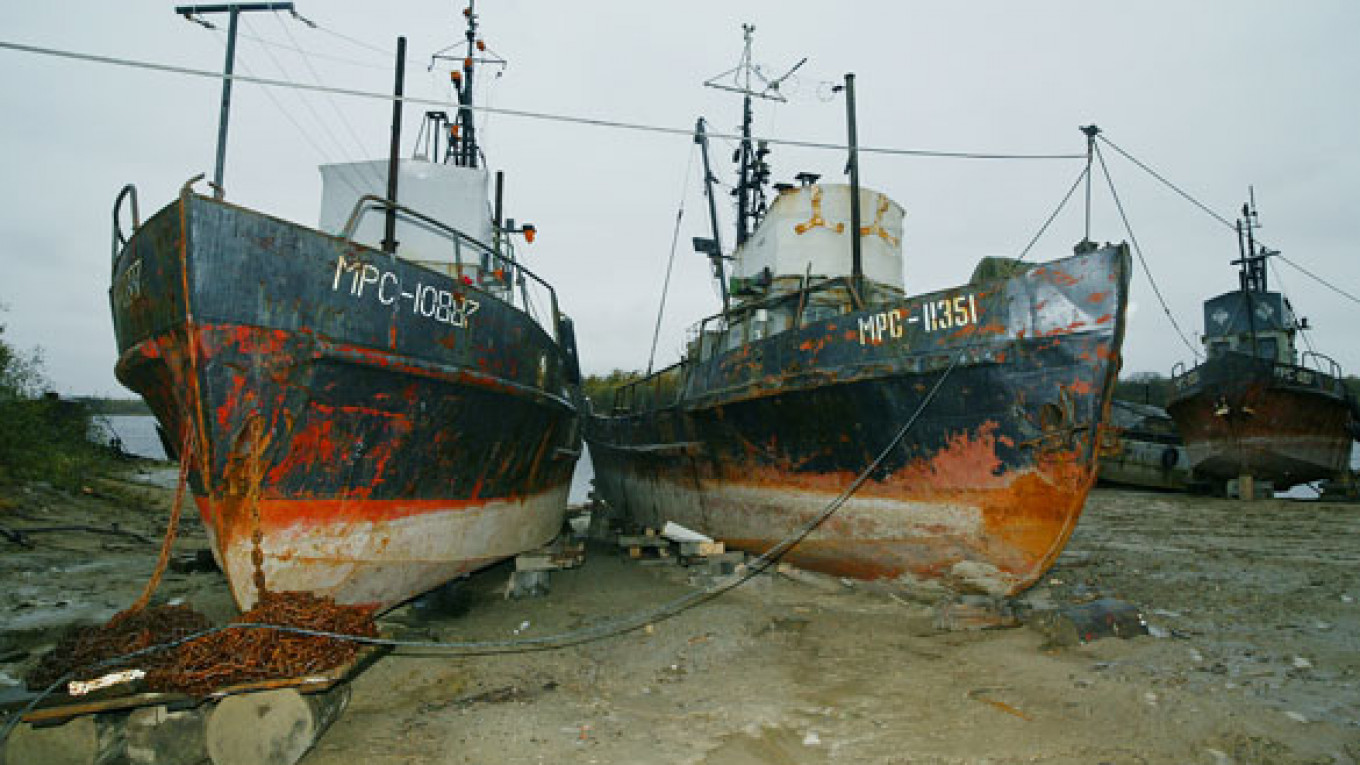The commercial shipbuilding industry is in dire straits — with a shrinking fleet and little domestic manufacturing — and requires $12.8 billion in investment over the next 10 years to maintain the country’s fishing fleet, the government said Wednesday.
Less than 10 percent of newly purchased fishing ships were made domestically, and the government plans to continue to look outside the country to shore up the fleet.
Fishing and shipbuilding were the topics of Wednesday’s session of the newly established subcommission on fishery and aquatic farming of the Union of Entrepreneurs and Industrialists.
Igor Orlov, chief executive of the Yantar Baltic Shipbuilding Plant, acknowledged that the shipbuilding industry was in disarray but emphasized its potential to make a comeback.
“The Baltic plant builds the world’s most sophisticated warships. It is capable of building fishing ships too,” Orlov said.
“Fishing needs state help in any case,” he added. “It is logical to spend the money within the Russian Federation.”
The industry is in crisis because of the state of its fleet and declining resources, said Andrei Krainy, head of the Federal Fisheries Agency.
As of last year, the fleet consisted of 2,419 ships, many of which were built during Soviet times. The number has shrunk by 26 percent since 1992, with a corresponding reduction in qualified personnel.
Krainy opposed the “quota for a keel” proposal made by United Shipbuilding head Roman Trotsenko, who wants to see a system whereby ship owners would receive better fishing rights in exchange for buying Russian-built vessels.
Krainy argued that Trotsenko’s proposal is impractical, since domestic shipyards are not designed for the production of fishing ships and local shipbuilding technology cannot produce modern trawlers quickly or cheaply enough.
German Zverev, member of the subcommission and president of the Association of Pollack Producers, said the nature of the fishing industry is changing.
To maintain current levels of production, less profitable marine bio-resources will have to exploited, fishing ships will have to expand further into international waters and fish farming needs be developed, Zverev said.
Russia currently produces about 114,000 tons of farmed fish a year, which is less than 5 percent of the total harvest. Worldwide, 38 percent of harvested fish come from farms.
Although the country’s cold waters are a challenge for fish farming, it is estimated that oyster farming could be done in the Far East and be worth more than $10 million per year. Salmon, sturgeon and seaweed are also viable for farming in Russian waters.
Price fluctuations make economic modeling difficult and complicate planning, Zverev said. He said prices for seafood are considerably lower today than they were in the 1970s, when the Soviet fishing fleet was at its peak of capacity.
Speaking Tuesday at a round-table discussion on investment in the fishing industry, First Deputy Prime Minister Viktor Zubkov presented a more positive picture. The total harvest has risen by 12 percent in the last three years to 3.8 million tons this year, he said, and sales have increased by 21 percent in the same period, to reach $3.3 billion.
Zubkov credited the state for much of that success.
The fishing industry received $457.8 million in government support this year and will receive the same amount next year, Zubkov said. The industry can also look forward to a program of low-interest credit, loans with subsidized interest and lower fees for resource use.
Zubkov said 50 ships have been overhauled in the last two years, and 32 new ones have been ordered. Of those 32, only three were Russian-made. Eleven seaports that serve the fishing industry are being reconstructed under a federal targeted program.
Legislative measures will also work to the industry’s advantage. New quality standards for fish products came into force at the beginning of this month, which will encourage consumption. A strategic plan for the development of the fishing ship industry will be submitted to the State Duma at its spring session next year. The draft of the plan estimates the need for investment in the shipbuilding industry through 2020 at $12.8 billion. It sets investment in fishing, market development and resource management for the same period at $410 million to $780 million. The development plan foresees the use of foreign shipbuilders to fortify the Russian fleet. Business owners will be offered attractive purchase conditions and lease agreements.
A Message from The Moscow Times:
Dear readers,
We are facing unprecedented challenges. Russia's Prosecutor General's Office has designated The Moscow Times as an "undesirable" organization, criminalizing our work and putting our staff at risk of prosecution. This follows our earlier unjust labeling as a "foreign agent."
These actions are direct attempts to silence independent journalism in Russia. The authorities claim our work "discredits the decisions of the Russian leadership." We see things differently: we strive to provide accurate, unbiased reporting on Russia.
We, the journalists of The Moscow Times, refuse to be silenced. But to continue our work, we need your help.
Your support, no matter how small, makes a world of difference. If you can, please support us monthly starting from just $2. It's quick to set up, and every contribution makes a significant impact.
By supporting The Moscow Times, you're defending open, independent journalism in the face of repression. Thank you for standing with us.
Remind me later.






